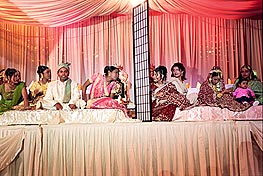
|
| A screen separates the couple |
Synthi & Mohamed
Author: Mary Ann Hamilton, Getting Married project
Getting Married: Maysha Kabir, known as Synthi, and Mohamed Kamruzzaman, both from Bangladesh, married in Sydney early in 2003 in a colourful celebration incorporating many elements of a wedding steeped in the Bengali culture of Bangladesh. The couple, their families and their community affirmed life in Australia, their commitment to Islam and their love of Bengali culture and traditions.
Getting married Bangladeshi-style
The bride arrives
The wedding day is here. Synthi arrives at the function centre in Campsie, southwest
Sydney, accompanied by her family. She is ushered into a waiting room where
her mother, sister and sister-in-law supervise the finishing touches to her
wedding costume; a beautiful red wedding sari richly embroidered with thick
gold thread and beads.
Synthi’s parents made a special trip to Bangladesh to find the sari and
wedding jewellery: the headdress, the nose ring, the necklace, bangles and clothing.
As is customary, the groom’s parents paid for Synthi’s wedding costume
and the Synthi’s parents paid for Mohamed’s.
Mehndi day
Synthi’s hands and feet have been decorated with henna, a custom which
is part of mehndi day, celebrated in separate functions for the bride and groom
a day or two before the wedding. As well as decorating the hands with henna,
this day traditionally often includes the ritual bathing of the bride by her
mother and aunts, and the groom by his close relatives.
Turmeric day
Several days prior to mehndi day is the traditional turmeric day, when the parents
presented Synthi and Mohammed with their wedding clothes and jewellery. Turmeric
paste was rubbed on their skin in a ritual of cleansing or purification (turmeric
is also known to be good for the complexion!). Gold and silver pompom-like bracelets,
rhaki, were tied to the wrists of bride and groom respectively.
Synthi and Mohamed also held their turmeric days in separate celebrations on
different days. In Bengali culture the bride and groom should not see each other
from the turmeric day until the wedding day. Mohamed and Synthi could not see
why this tradition should be upheld in Australia in 2003 and so they planned
that Mohamed should attend Synthi’s celebration and offer her a gift of
turmeric paste.
As the day drew closer, they both became a bit nervous about carrying out the
plan as it was such a dramatic break from tradition. As Mohamed entered the
women’s gathering he caused a moment of concern among the guests, but
an older relative quickly moved to greet Mohamed, breaking the tension.
 |
 |
|
(Synthi) I’m glad we did it. It was fun and it was accepted.
As she was leaving an older, married cousin of mine came up to me and
said, ‘that was such a mad idea. I’m glad I came – I
wouldn’t have missed the fun for anything’.
|
Arrival of the groom
At the wedding venue, Synthi sits very still in the waiting room as she tries
to get used to the weight of the gold-embroidered veil and her jewellery. Her
mother, sister and sister-in-law keep an eye out for the groom’s wedding
party.
When Mohamed arrives and makes his way into the hall he is stopped by a mischievous
group of Synthi’s female relatives who joke with him and demand a payment
for entry.
 |
 |
|
“In Bangladesh the sister and sister-in-law would tease
the groom all day – he has to pay to get into the house, they will steal
his shoes and he has to pay to get them back, he has to pay to wash his hands
before he eats – he has to pay for everything!”.
|
The girls are finally satisfied that they have tormented him enough and let
him in. He makes his way through the hall to the stage where he is seated on
a low couch and surrounded by his sisters.
Synthi is carried to the stage in a curtained sedan chair. She takes her place
with her sister and sister-in-law on another couch. The couple are seated beside
each other but are separated by a screen. In accordance with tradition, they
remain silent and separated throughout the formal ceremony.
 |
 |
|
(Mohamed) In Bangladesh it is tradition that the bride and groom
should not see each other’s face until the nikah or wedding ceremony
is performed – these days they sit on either side of the partition
before they are actually married as a symbol that they are not yet joined
in marriage.
|
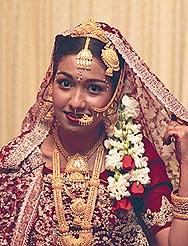
Synthi in her bridal costume
The nikah
 |
 |
|
I was really scared the whole time – every time I looked
up, my sister and sister-in-law told me ‘look down’. A bride
is not supposed to smile because that would mean that she is glad to be
leaving her family.
|
The heart of a marriage in Muslim culture is the nikah-nama, the marriage
contract made between male representatives of the bride and groom.
Four hundred and fifty wedding guests have gathered to witness the making of
a marriage contract between Synthi and Mohamed – and it seems they are
intent on chatting all the way through the proceedings until the Imam makes
a stern request for some quiet while he reads from the Qur’an. The verses
he reads set out the necessity for all men and women to marry, and provide instruction
on how to conduct married life in Islamic law.
The marriage contract is formally made between Synthi and Mohamed’s respective
fathers. According to Islamic law the contract must include a dowry of money
or valuables promised by the groom’s family to the bride. This is given
to the bride at the time of her marriage and is held in safekeeping until she
requests it.
The Imam asks both Mohamed and Synthi whether they will accept each other as
husband and wife. They agree and are now married under Islamic law. With their
signatures on their marriage certificates they are also man and wife under Australian
law.
Now that the formalities are over, the more informal festivities can begin.
Getting together
Meeting in the heart of the family
Synthi and Mohamed have known each other for about two years. They first met
at a family wedding after which their families became close. The young couple’s
relationship developed over the following months in the heart of this family
relationship.
 |
 |
|
At first it was like a joking and teasing relationship. I used
to tease her about her Higher School Certificate which was coming up later
in the year – so it started as a friendly relationship.
|
Then, in 2001, Mohamed and his family attended Synthi’s brother’s
wedding. It was there that he began to see Synthi differently.
 |
 |
|
She was dressed traditionally in a sari and looked like the beautiful
woman she is rather than the little girl who I joked around with. I decided
I wanted to get to know Synthi on a more personal level. At a barbeque
shortly after the wedding we exchanged phone numbers and email addresses
and kept contact through SMSing and emailing.
|
Talk of marriage
As young Australians whose heritage is Bangladeshi, Synthi and Mohamed were
given a certain amount of latitude in socialising together within their friendship
and family circle. They continued to meet up at picnics and barbeques and other
family events and came to know each other a little better.
At the same time they were both quite aware that, in their cultural community,
the question of marriage must involve their parents. It came as little surprise
to Mohamed that his parents soon noticed his interest in Synthi and asked him
if he would consider marrying her.
 |
 |
|
All my life I did not like the idea of arranged marriages. I
could not understand how two people who did not know each other could
expect to spend the rest of their lives happily together so I told my
parents I needed time to think about this…
|
The proposal
 |
 |
|
I knew my parents would push the issue so I arranged to talk
to Synthi about it and let her know that her parents may approach her
about marrying me… I said ‘I want your decision to be based
on what you see in front of you and what you think of me’…
|
 |
 |
|
I was so shocked – I couldn’t speak. I had not thought
of marriage at all before then. I had always expected that my parents
would arrange my marriage – that is the way I have been brought
up – but I felt I was too young to get married. I wanted to finish
my studies first…
|
Shortly after this, a family member told Synthi that a proposal of marriage
had been made by Mohamed’s parents. Mohamed was known as a man of good
prospects, so he would be able to look after Synthi materially. He was also
known as a kind and respectful person and a man of faith – a very good
match for Synthi. Everyone wanted to know whether she would accept the proposal
or not.
Synthi had just begun university at the time and was not due to complete her
studies for another two years. She was concerned that it would be too hard to
juggle studies and the responsibilities of married life.
Finally, a month after receiving the proposal, after much thought and with
the assurance that the wedding would not have to be straight away, she accepted
Mohamed’s proposal of marriage.
Betrothal
In traditional Bengali culture the marriage proposal is made when the groom’s
friends and relatives (but not the groom himself) visit the bride and make a
formal offer of marriage to the bride’s parents. The proposal is formally
accepted when members of the bride’s family and friends make a reciprocal
visit to the groom and his family.
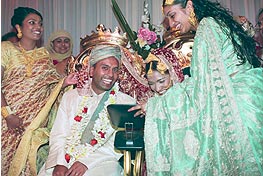
The couple after the nikah
In June 2001, Synthi and Mohamed’s marriage was announced during an evening
of formalities. Mohamed’s family visited the Kabirs’ family home
and formally asked for Synthi’s hand in marriage for Mohamed. The proposal
was accepted and then the dates were set for the wedding day and the other ceremonies.
The evening’s events were overseen by the Imam who offered prayers from
the Qur’an. The couple exchanged rings as a symbol of the verbal agreement
they made to marry.
 |
 |
|
It was a really nerve-wracking night for it was the first time
that Synthi and I were together in front of our parents.
|
Getting ready for marriage
Initially after their engagement the couple met quite frequently and openly
in front of their parents. But as the months went on their parents warned them
against such informal contact, which is not acceptable between young unmarried
people in their community. Mohamed continued to call Synthi every day, and through
this period, as they prepared for their wedding, day they became very close.
 |
 |
|
He became a close friend and he understood my reluctance to
marry so young. I felt he was always on my side… He makes me feel
on top of the world and I know he cares for me.
|
In June 2002, a new, earlier date for the wedding was settled by the parents.
Mohamed and Synthi would be wed in January 2003, just before the beginning of
Synthi's last year of study. While this was sooner than they had planned, both
Mohamed and Synthi were pleased in the sense that the marriage would free them
up finally to be together with the blessing of their parents and community.
The wedding concludes, the party begins
The celebration of a marriage
After the nikah the couple look markedly relieved. The screen that
has separated them is taken down, and they sit together for the first time in
the proceedings. While Mohamed has been smiling broadly all evening, Synthi
is now able to smile without censure.
A nest of ten wedding cakes, enough to feed the hundreds of guests, is raised
to the stage on a table. The couple cut the centre cake and take turns at feeding
each other and their new family members, a sign of exchange, nurturing and welcome.
This ritual of feeding continues as they enjoy their meal.
Looking in the mirror
When they have eaten, the couple are given a mirror by one of their
sisters. They see themselves together as a couple for the first time.
 |
 |
|
When we are shown the mirror we are supposed to say what we
see. Mohamed said to me – ‘I see an angel!’.
|
While the couple attend to each other on the stage, the wedding guests enjoy
a festive meal and take the chance to catch up with each other. Children are
fed before they run off to slide on the polished dance floor and teenagers take
the opportunity to chat and joke around to the accompaniment some popular Bengali
songs.
Before they leave each of the guests closest to the family takes their turn
to greet and congratulate the bride and groom.
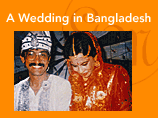
A wedding in Bangladesh
Shajeda and Golam had an unconventional wedding in Bangladesh in 1985.
>> Read their story
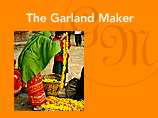
Hindu weddings: the garland maker's story
Gnanam has been making garlands for Sydney's Indian community for 30 years.
>> Read her story
Life together
Going to a new home
After the wedding Synthi goes to her new home with Mohamed and his family. Her
first steps inside her new home are imprinted in a special coloured powder strewn
on the doorstep. Her mother-in-law offers her a sweet drink and leads the couple
to their bedroom decorated in flowers and candles.
A reflection on two months of married life
As in most marriages in their community, when Synthi married Mohamed
she accepted a number of obligations and responsibilities to Mohamed’s
family as well as to Mohamed.
 |
 |
|
At first it was quite hard, I have a lot of responsibilities,
to Mohamed and also to his parents. No one is telling me to look after
and help them but I want to do it… At the same time I have to manage
time for my studies. I am learning to manage the system, juggling between
my duties here – to this big kid and his family – and getting
my uni work done.
|
Similarly the past few months provided Mohamed with a profound insight into
the responsibilities and joys of married life.
 |
 |
|
Islam speaks about marriage being half your life and your religion.
I never really understood until now that I am married. Marriage teaches
you to be caring, patient, understanding and loving – previously
my life was about ‘I’, and now it is about ‘us’.
|
> Take a look at some more weddings
|






